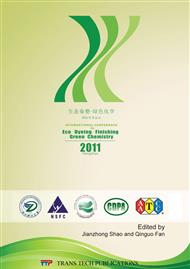p.508
p.512
p.517
p.522
p.526
p.531
p.536
p.540
p.544
Preparation and Application of Waterborne Unsaturated Fiber Crosslinking Agent
Abstract:
A polymer was synthesized by emulsion copolymerization of styrene (St), glycidyl methacrylate (GMA) and isoprene. Sodium dodecyl sulfate was used as emulsifier, while sodium persulfate was the initiator. The effect of the polymer on paper wet-strength and dry-strength was investigated. The polymer contains phenyl groups which confer hydrophobicity to fibers so as to improve paper wet performance, and epoxy groups that can react with carboxyl, and hydroxyl groups in fibers aiming to increase paper strength, and double bonds toward self-polymerization in certain condition. Prepared polymer was applied to make handsheets of wood pulp and the handsheets were cured by high temperature or UV radiation. The Raman spectra showed that the polymer contained hydrophobic benzene, epoxy groups and double bonds. The SEM analysis indicated that paper fracture was caused by fiber breakage, which supported the theory that the polymer could increase interfiber-bonding strength. The experimental results indicated that the best monomer molar ratio was 1:1:1, while the optimum reaction conditions were a temperature of 40 °C and a reaction time of 5 hours.
Info:
Periodical:
Pages:
526-530
Citation:
Online since:
January 2012
Authors:
Price:
Сopyright:
© 2012 Trans Tech Publications Ltd. All Rights Reserved
Share:
Citation:


